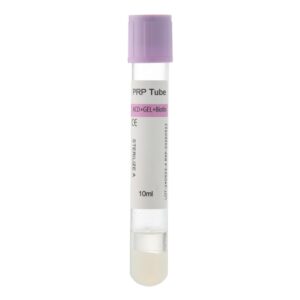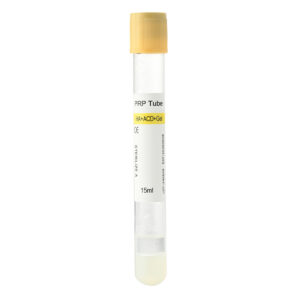PRP vs Stem Cell Therapy: What’s the Difference? In the rapidly advancing field of orthobiologics and regenerative medicine, practitioners increasingly face the task of selecting the most appropriate autologous therapy for tissue repair. Although patients often discuss PRP and stem cell therapy interchangeably, these treatments represent distinct biological modalities with unique mechanisms of action, regulatory classifications, and procurement requirements.
For medical institutions and distributors, understanding these distinctions is not merely an academic exercise—it is a strategic necessity. The choice between these therapies dictates clinical infrastructure, staffing requirements, and, crucially, the selection of medical-grade consumables. This guide provides a professional examination of the differences between Platelet-Rich Plasma (PRP) and stem cell therapies, focusing on the technical prerequisites for clinical success.
Divergent Biological Mechanisms: Signaling vs. Differentiation
To appreciate the clinical utility of PRP vs stem cell therapy, one must first delineate their physiological roles in the healing cascade. Both are autologous treatments, derived from the patient’s own body to minimize immunogenic reactions, but their therapeutic payloads differ significantly.
Platelet-Rich Plasma (PRP): The Paracrine Signaling Modulator
Clinicians define PRP by the concentration of platelets in a small volume of plasma at levels supra-physiological to baseline whole blood (typically 3–5 times baseline). The therapeutic efficacy of PRP relies on the degranulation of alpha-granules within the platelets. Upon activation, these granules release a potent cocktail of cytokines and growth factors, including:
- PDGF (Platelet-Derived Growth Factor): Initiates mitogenesis and angiogenesis.
- TGF-β (Transforming Growth Factor-Beta): Regulates cell proliferation and matrix synthesis.
- VEGF (Vascular Endothelial Growth Factor): Essential for revascularization of injured tissue.
PRP does not function by becoming new tissue; rather, it functions through paracrine signaling. It creates a hyper-physiologic environment that recruits the body’s systemic repair mechanisms to the site of injury and modulates the local inflammatory response.
Stem Cell Therapy: The Multipotent Regenerative Agent
Stem cell therapy, typically utilizing Mesenchymal Stem Cells (MSCs) harvested from Bone Marrow Aspirate Concentrate (BMAC) or Adipose-Derived Stromal Vascular Fraction (SVF), operates on the principle of cellular differentiation. These cells possess multipotency—the ability to differentiate into specific cell lineages such as chondrocytes (cartilage), osteoblasts (bone), or tenocytes (tendon). While MSCs also exhibit paracrine effects similar to PRP, their primary distinction lies in their potential to physically contribute to tissue regeneration in environments with significant structural deficits.
The Technical Determinants of Efficacy: Why Consumables Matter
A critical oversight in the comparison of PRP vs stem cell therapy is the assumption that all PRP is created equal. In clinical practice, the therapeutic potency of PRP is directly dependent on the technology used to prepare it. The Recovery Rate of the PRP tube determines the “dose” of the medicine.
Separation Gel Technology
The separation of blood components relies on specific gravity. Red blood cells (RBCs) are the heaviest, followed by white blood cells (WBCs) and platelets, with plasma being the lightest. A professional PRP tube employs a thixotropic separator gel with a precise density engineered to settle exactly at the interface between the RBCs and the plasma.
- Precision Engineering: If the gel density is incorrect, it can trap platelets in the RBC layer (reducing yield) or allow RBCs to contaminate the plasma (causing inflammation).
Sterility and Biocompatibility
Because clinicians re-administer PRP parenterally, regulators classify the collection tubes as medical devices. They must be certified Pyrogen-Free (free of endotoxins) and undergo rigorous sterilization (e.g., Gamma Irradiation). Using standard laboratory diagnostic tubes for therapeutic PRP poses significant safety risks, including chemical leaching and infection.
Medical professionals must prioritize sourcing from manufacturers who adhere to ISO 13485 standards. At Siny PRP, our manufacturing process focuses on the physics of separation, ensuring that our tubes deliver consistent platelet concentration factors (3x-6x) and absolute sterility, safeguarding both patient outcomes and clinical reputation.
Clinical Indications: Matching Therapy to Pathology
Understanding the biological differences helps in patient selection.
- PRP is the Gold Standard for: Soft tissue pathologies (Tendinopathy, Ligament sprains), mild to moderate Osteoarthritis (OA), and aesthetic applications (Skin rejuvenation, Hair restoration). Its ability to modulate inflammation makes it highly effective for pain management and recovery acceleration.
- Stem Cell Therapy is Reserved for: Advanced degeneration (Grade 3-4 OA), avascular necrosis, or significant tissue voids where structural rebuilding is necessary.
Due to the broader range of indications for PRP, it remains the foundational service for most clinics. This high volume necessitates a robust supply chain for PRP consumables.
Technical Protocols: A Comparative Step-by-Step Guide
For medical practitioners evaluating the implementation of regenerative therapies, understanding the granular technical steps is crucial. The operational divergence between PRP vs stem cell therapy dictates the necessary staffing, sterile field requirements, and equipment specifications.
Below is a technical breakdown of the standard operating procedures (SOPs) for both modalities.
The PRP Protocol: Precision in a Closed System
The preparation of Platelet-Rich Plasma is a closed-system process, typically completed in 15–20 minutes. The efficacy of this protocol relies heavily on the engineering of the centrifugation tube to maintain sterility and maximize platelet recovery.
- Step 1: Venipuncture and Anticoagulation: The clinician draws peripheral blood (typically 10 ml to 50 ml) directly into a specialized PRP vacuum tube.
- Step 2: Differential Centrifugation: The clinician places the tube in a centrifuge and spins it at a calibrated G-force (Relative Centrifugal Force). During this phase, the proprietary separator gel inside the tube activates.
- Step 3: Aspiration and Application: Once centrifugation is complete, the operator will observe a clear separation: the RBCs trapped below the gel, and the golden plasma supernatant above. The clinician simply inserts a syringe to draw off the platelet-rich layer (and the Buffy Coat, if the protocol dictates) for immediate injection.
The Stem Cell Protocol: Surgical Harvesting and Processing
In contrast to the “draw-and-spin” simplicity of PRP, stem cell therapy—specifically Bone Marrow Aspirate Concentrate (BMAC)—requires a surgical approach.
- Step 1: Surgical Preparation and Anesthesia: The procedure requires a sterile surgical field. The clinician places the patient in a prone or lateral position and administers local anesthesia (often with sedation) to the Posterior Superior Iliac Spine (PSIS) region.
- Step 2: Aspiration (Harvesting): A trocar (a large-bore needle) is advanced into the iliac crest. The physician must manually aspirate bone marrow in small fractions (typically 5-10ml per pull) to minimize peripheral blood infiltration. This step requires significant physician skill to access the marrow space accurately.
- Step 3: Filtration and Concentration: The raw aspirate contains bone fragments and fat, so the clinician must filter it. Then the clinician transfers the fluid to a specialized processing kit and centrifuges it to isolate the nucleated cells (where the Mesenchymal Stem Cells reside).
Operational Conclusion:
While stem cell therapy requires surgical skill and longer procedure times, the quality of the centrifugation tube technically defines how clinicians prepare PRP. A standardized PRP protocol using professional-grade tubes allows for reproducible results with minimal operator variability.
Ensure your clinical protocol is built on a foundation of reliability. Visit Siny Medical to view our technical guides and select the centrifugation tubes that align with your practice’s specific G-force and volume requirements.
Strategic Sourcing: Criteria for Evaluating Medical-Grade Centrifugation Supplies
Identifying a manufacturing partner capable of meeting clinical standards is pivotal. When evaluating suppliers for regenerative consumables, procurement teams should utilize the following technical criteria:
1. Material Composition and Durability
Preference should be given to medical-grade PET (Polyethylene Terephthalate) or strengthened borosilicate glass. PET is increasingly favored for its resistance to fracture under high G-force centrifugation, ensuring safety for personnel and patients.
2. Anticoagulant Formulation
The choice of anticoagulant—typically Sodium Citrate or ACD-A—must align with the clinic’s protocol. Clinicians often prefer ACD-A because it maintains platelet morphology and prevents premature activation before injection.
3. Surface Passivation
High-quality tubes feature siliconized interiors to prevent platelet adhesion to the tube walls. This minimizes yield loss and prevents the release of growth factors before the optimal time (injection).
Summary
While PRP vs stem cell therapy differ in their biological mechanisms and operational requirements, they share a common dependency: the quality of the preparation determines the quality of the outcome. PRP remains the cornerstone of regenerative medicine due to its safety profile, cost-effectiveness, and broad clinical utility.
For medical practitioners and procurement teams, the focus must shift from merely selecting a therapy to selecting the right technology to deliver that therapy. Efficacy is not just about the doctor’s technique; it is about the precision of the separation. By partnering with manufacturers who prioritize material science and sterilization standards, medical providers ensure that their regenerative treatments are safe, consistent, and effective.
FAQs
Q: What is the comparative safety profile of PRP vs stem cell therapy?
A: Clinicians generally consider PRP to have a superior safety profile with fewer contraindications. Because it is a peripheral blood derivative obtained through a simple blood draw, it carries minimal risk of infection or complication compared to the invasive harvesting required for bone marrow– or adipose-derived stem cells.
Q: Why are standard diagnostic tubes unsuitable for PRP preparation?
A: Diagnostic tubes are designed for analysis, not reintroduction into the body. They lack pyrogen-free certification and often contain additives that are not biocompatible. Using such tubes for PRP is an off-label practice that violates safety standards and risks patient health.
Q: How does the “Gel Separator” in Siny PRP tubes improve outcomes?
A: The specific gravity of our gel is calibrated to settle precisely between red blood cells and plasma. This physical barrier allows for the maximum recovery of platelets (high yield) while preventing red blood cells from contaminating the therapeutic plasma, ensuring a purer, more effective sample.
Q: Is there a cost difference in equipping a clinic for PRP vs Stem Cells?
A: Yes, significant. PRP requires minimal capital expenditure (a centrifuge and tubes). Stem cell therapy often requires expensive surgical kits, filtration systems, and disposables that can cost 10x-20x more than a PRP kit.
Q: Can I customize the anticoagulant in the PRP tubes?
A: Professional manufacturers often offer customization. Siny PRP provides options for different anticoagulants (like Sodium Citrate or ACD-A) and tube volumes (8ml to 50ml) to suit specific clinical protocols. Such as aesthetic vs. orthopedic applications.





